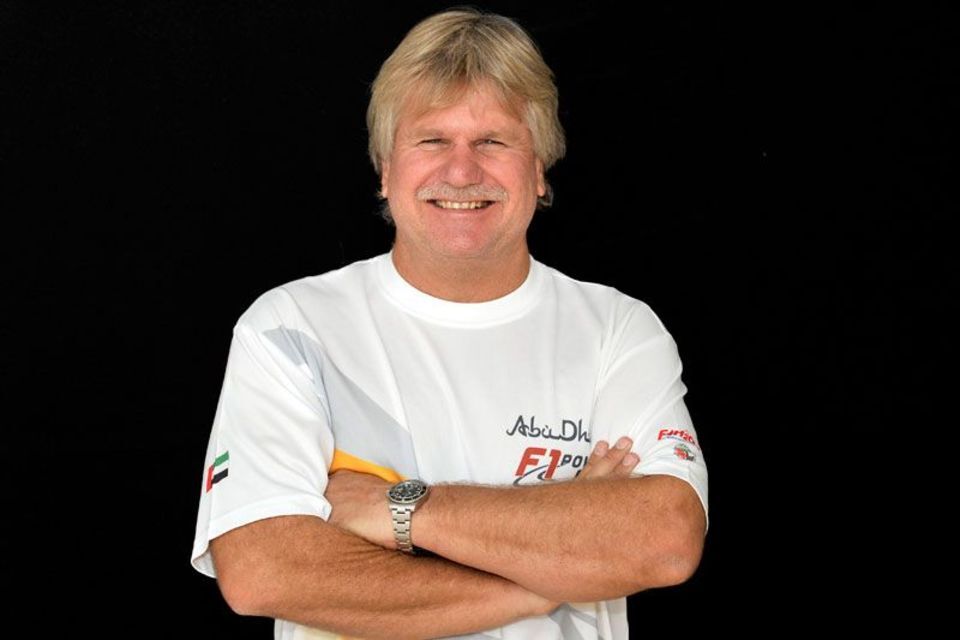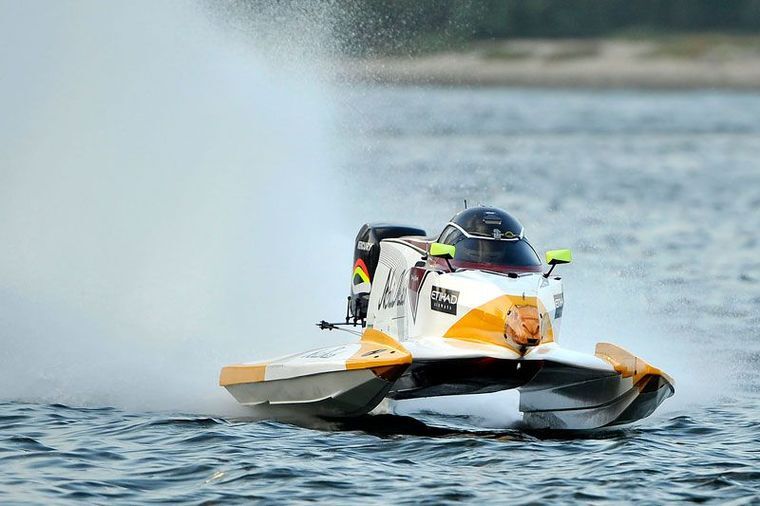
ABU DHABI - April 29, 2013 - As the UIM F1 H2O World Championship gets ready to kick off it's historic 30th anniversary year of racing, who better to ask his thoughts about the current state of the F1 H2O series than four-time World Champion and Hall-of-Fame driver Scott Gillman.
The Race Team Manager of Team Abu Dhabi, winners of last season's Team Championship for the sixth time in the last 10 years, responded to a myriad of questions about how healthy he saw the sport as it is today and how the series has evolved since he started racing F1 boats just under 30 years ago.
SAFETY:
"When I first started racing in F1 on the American IOGP tour back in the mid-1980's we were racing wooden boats with no safety capsules or harnesses, said the California driver. "The whole philosophy which was followed back in those days, was, if a driver had an accident, you'd want him to get as far away from his boat as possible when it happened.
Crashing without the use of safety harnesses, would sometimes cause him to skip along the water like a flat stone. Yes, the pilot would move away from the crash but he would possibly also get massive internal injuries doing so.
The sport took some hard knocks before drivers and designers came up with the needed revisions. Finally, a lot more thought to safety was being put in place to protect the drivers. In 1987 we finally saw the first steps of "safety capsules" in America and Europe and its remarkable how it has improved year after year over the last 25 Grand Prix seasons.
Don't get me wrong, we still have incidents where drivers can get injured. However, it's world's better than where we started from back when v-bottom boats developed into crude catamarans forty years ago to what is now the state-of-the-art racing hulls we see at Grand Prix circuits around the world today."
F1 H2O GROWTH:
"I was a back-to-back North American Champion and always dreamed of racing on a "world series" stage. When I arrived for the opening Grand Prix in Hungary in May of 1997 I brought one mechanic (Troy Wood) and a small motorhome that we would live in from race to race during the summer.
Budgets were small then.
I won the title, that, my rookie season, racing the same SEEBOLD hull that I had raced the previous three years in America. It was a fun year. We took pole the very first race in Hungary and were leading when I was forced out of the race. I went on after that event to win four straight Grand Prix's officially earning my first World Title in Abu Dhabi.
It was double special to have both my father and my mother who are both gone now with me for that season's final race.
Seventeen years ago most of the venues were in Europe, lovely small to medium markets in sometimes intriguing places. Back in 1997 every race team drove from race to race and you needed a scooter to get around with especially to your hotel from the paddock.
Today, everything is shipped via container. The crowds back then were smaller than todays events. But like today, they also were knowledgeable and enthusiastic.
The big reason for our growth into larger markets today, is because of our worldwide television exposure. You combine this with our "live" internet broadcasts for people around the world who can't otherwise follow the races and add a magazine show for delayed broadcasts in a magazine format and you have a state of the art package to give people around the globe many ways to enjoy F1 H2O.
We are now racing in large markets in front of many more people. Today, we must continue to educate people about the excitement and drama of this "edgy" sport around the world that still captivates fans on three different continents.
RACING RIVALS:
Of course, my big rival was always Guido Cappellini of the DAC Team from Como, Italy. For a ten year stretch it was either Guido winning the title or yours truly. Final count if anyone cares, he captured six titles and I earned four.
I will say, however, that I'll always be proud of the fact that 90% of my finishes were on the podium which is a record that no one else has.
It's funny, Guido came to America and raced with us for a few years. At that same time, he was competing on the then, mostly a European circuit. He was smart. He was racing twice as much as most drivers each season and learning very quickly the subtleties of the sport at the same time.
When I look back on it today, Guido and I ended up racing against each other for almost 20 years.
Our history together goes back to the late 1980's when he and I would line up side by side on the start pontoon in America in such locals as Minneapolis, Minnesota and Fort Lauderdale, Florida fighting for a lowly tenth place finish earning a few points while learning the sport.
I know he never won a race on the very talented North American F1 tour back in those years and I think it may still bother him a bit.
Over the years, Guido and I handled our rivalry the only way true competitors could. At many races that we competed in, we didn't even take the time to speak or even look at each other. Sometimes we would push each other to the limit, our boats to the maximum, including just practice, to see who could get the faster time even thought it didn't count for the race. That's how competitive we were.
Another World Champion, Jonathan Jones, was always tough and a world class driver. He even captured the USA series before I started racing boats back in 1985 which was no easy task for a "foreigner" back then to take the glory away from the Seebold family, Chris Bush and others.
A pair of Fin's, with that Nordic determination, Pertti Leppala and later on in my career Sami Selio, were both tough rivals as well. As well as Italian Francesco Cantando. I could go on and on.
However, the real difference from 17 years ago to what we are seeing today, is that if you look at the current line-up of pilots, not two or three, but seven or eight drivers, could win any event at any particular Grand Prix weekend. The talent is just that good.
This, is what makes the series so very exciting today!
RACING PHILOSOPHY:
Todays racing is totally different than when I first came on the series back in 1997. Now, the Grand Prix's are shorter, more like long sprint events of 45 minutes making it fit well with the worldwide television packages that are offered. But, for a driver, there is no letting up, it's flat out from start to finish.
In todays world, with horsepower, not as much of a factor than it was before because of today's engine limiters, drivers are now racing shorter and wider boats that fly off the corners delivering maximum acceleration from point to point rather than top-end speed.
There are no two-pin race courses anymore on the F1 H2O World Championship tour.
Today, the courses are highly sophisticated multi-pin race circuits that take away the horsepower advantage which then opens it up to all pilots for a better chance of winning and reaching the podium. It makes it a lot more exciting for the fans as well.
TEAM ABU DHABI:
I maybe a bit jaded, since I've been with the great people at the ADIMSC (Abu Dhabi International Marine Sports Club) for over a decade, but all personnel between these walls are true professionals who really want to make all of powerboat racing, including F1 H2O and Class-1 the most recognized series of any racing form worldwide.
Watching the growth of our current family of drivers, Thani Al Qamzi and Ahmed Al Hameli along with rookie to F1 Rashed Al Tayer all coming from the ranks of personal water craft to smaller Formula classes to F1, makes me proud that our training program is second to none. We aren't standing pat, we continue to work with new individuals for the future. It's special here in Abu Dhabi."
So, for Scott Gillman, a racer who's influence and talents have changed the face of the sport of F1 H2O, but at the same time, oddly didn't discover the competition of powerboat racing until long after making a name for himself in other forms of competition including motocross and off-road racing. Scott has more plans, as he continues to grow with the series he loves so much.
Stay tuned, the "So-Cal" kid after 17 years is just getting started. The Hall-of-Famer has a lot more to give to the sport of F1 H2O racing. It will be fun seeing what he has planned for us next!
Be In The Know - With F1 H2O!






